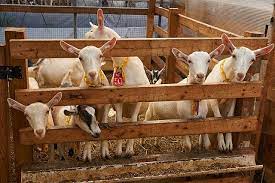The domestic goat is a subspecies of the wild goat of southwest Asia and Eastern Europe. It is a member of the bovine family, and is closely related to the sheep, both being in the “goat antelope” group.
Domestic goats are one of the oldest domesticated species. For thousands of years, they have been used for their milk, meat, hair, and skins all over the world. In the last century they have also gained some popularity as pets.
Management of breeding goat stock
Bucks intended for breeding should be kept in good condition.
Provide adequate amount of food because poorly fed goat are sluggish and tend to have reduce libido (the keenness to mate).
Reduce high phosphorus diet because it reduces fertility in terms of sperm quality.
Avoid Vitamin A and iodine deficiency (deficiency cause reduce libido)
Exercise yard should be provided
Dehorned bucks regularly and the hooves should be trimmed to reduced limpness.
Provided good pasture.
In absence of pasture provide concentrate up to 0.75kg / day/buck.
Two (2) weeks before and during breeding season, increase the level of concentrate by 0.45 to 0.9kg.
To achieve good breeding efficiency mating should be 1:50 (hand mating).
1:40 (pasture mating)
Management of Breeding Does
The Management of breeding does is related to Physiological phases:
The dry period
Pregnancy period
Lactation period
Dry period
This is the period when the does is last productive
Place the does or high level of nutrition (flushing) usually done for dairy goats).
Provide exercise yard
Nanny kids (yet to reproduce should not be breed too fat). Age of puberty is between 6-7 months.
Read Also : The Basics to Successful Goat Farming Business
Pregnancy period

During the last 6-8 weeks of frequency, the doe should be placed on high level of nutrition (steaming up).
Period enough water and mineral lick
At last week of pregnancy, concentrate of about 0.3 to 0.5kg should be given.
Uneasiness, restlessness, sitting down and getting up, smelling the ground, appearance of water bag are the signs of parturition.
Watch the doe closely coming kidding which should be completed in 2 to 3 hours whish may be longer in cases where the doe produce more than 1 kid.
Observe the doe careful in case (Dystocia) and also size of the foetus can also pose difficulty during kidding.
Lactation period
Provide enough pasture and concentrate to the lactating doe.
Management of kids
Immediately after with, clean the air passages if the kids is that breathing
Use straws and tickle the nostril or tongue of the kind to stimulate respiration
If it still doesn`t breath take it by its hind leg and turn it upside down for some time or poor cold water on the kind or give it kiss of life (month to month respiration)
After all these and it still doesn’t breath then it may die or survive and be very weak
Take care of the navel by dipping it in 7% iodine solution to prevent infections.
Read Also : Proper Wastes Treatment and Disposal Methods
